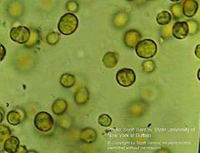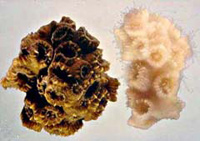Zooxanthellae. What's That?
 Most reef-building corals contain photosynthetic algae, called zooxanthellae, that live in their tissues. The corals and algae have a mutualistic relationship. The coral provides the algae with a protected environment and compounds they need for photosynthesis. In return, the algae produce oxygen and help the coral to remove wastes. Most importantly, zooxanthellae supply the coral with glucose, glycerol, and amino acids, which are the products of photosynthesis. The coral uses these products to make proteins, fats, and carbohydrates, and produce calcium carbonate (Barnes, R.D., 1987; Barnes, R.S.K. and Hughes, 1999; Lalli and Parsons, 1995; Levinton, 1995; Sumich, 1996). The relationship between the algae and coral polyp facilitates a tight recycling of nutrients in nutrient-poor tropical waters. In fact, as much as 90 percent of the organic material photosynthetically produced by the zooxanthellae is transferred to the host coral tissue (Sumich, 1996). This is the driving force behind the growth and productivity of coral reefs (Barnes, 1987; Levinton, 1995).
Most reef-building corals contain photosynthetic algae, called zooxanthellae, that live in their tissues. The corals and algae have a mutualistic relationship. The coral provides the algae with a protected environment and compounds they need for photosynthesis. In return, the algae produce oxygen and help the coral to remove wastes. Most importantly, zooxanthellae supply the coral with glucose, glycerol, and amino acids, which are the products of photosynthesis. The coral uses these products to make proteins, fats, and carbohydrates, and produce calcium carbonate (Barnes, R.D., 1987; Barnes, R.S.K. and Hughes, 1999; Lalli and Parsons, 1995; Levinton, 1995; Sumich, 1996). The relationship between the algae and coral polyp facilitates a tight recycling of nutrients in nutrient-poor tropical waters. In fact, as much as 90 percent of the organic material photosynthetically produced by the zooxanthellae is transferred to the host coral tissue (Sumich, 1996). This is the driving force behind the growth and productivity of coral reefs (Barnes, 1987; Levinton, 1995).
 In addition to providing corals with essential nutrients, zooxanthellae are responsible for the unique and beautiful colors of many stony corals. Sometimes when corals become physically stressed, the polyps expel their algal cells and the colony takes on a stark white appearance. This is commonly described as "coral bleaching" (Barnes, R.S.K. and Hughes, 1999; Lalli and Parsons, 1995). If the polyps go for too long without zooxanthellae, coral bleaching can result in the coral's death.
In addition to providing corals with essential nutrients, zooxanthellae are responsible for the unique and beautiful colors of many stony corals. Sometimes when corals become physically stressed, the polyps expel their algal cells and the colony takes on a stark white appearance. This is commonly described as "coral bleaching" (Barnes, R.S.K. and Hughes, 1999; Lalli and Parsons, 1995). If the polyps go for too long without zooxanthellae, coral bleaching can result in the coral's death.
 Because
of their intimate relationship with zooxanthellae, reef-building corals respond to the environment like plants. Because their algal cells need light for photosynthesis, reef corals require clear water. For this reason they are generally found only in waters with small amounts of suspended material, i.e., in water of low turbidity and low productivity. This leads to an interesting paradox-coral reefs require clear, nutrient-poor water, but they are among the most productive and diverse marine environments (Barnes, 1987).
Because
of their intimate relationship with zooxanthellae, reef-building corals respond to the environment like plants. Because their algal cells need light for photosynthesis, reef corals require clear water. For this reason they are generally found only in waters with small amounts of suspended material, i.e., in water of low turbidity and low productivity. This leads to an interesting paradox-coral reefs require clear, nutrient-poor water, but they are among the most productive and diverse marine environments (Barnes, 1987).
 Deep Sea Crabs
Deep Sea Crabs